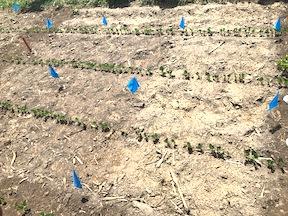
Herbicide-resistant weeds will be forgotten if Vaishali Sharda is successful with her spray-on bioplastic. The Kansas State University researcher recently received a $6 million grant to continue her work using bioplastic to control weeds and reduce soil erosion.
“Creating a protective layer over soil when growing field crops could help farmers better manage many issues at once,” Sharda said. “Covering soil with sheet plastic prevents weed growth, erosion, and moisture loss, but using large amounts of plastic creates waste, isn’t eco-friendly, and is too costly for field crops.”
Sharda’s research focuses on locally sourced types of bioplastics designed to fully break down into safe by-products. They could provide a green way to control weeds, fertilize crops, protect soil and water resources, and work with nature to better manage fields.
“We’re still in the experimental stage of testing biopolymers in the lab and greenhouse, as well as in some field trials in Nebraska,” says Sharda. “We’re focused on developing biopolymers that will last through the growing season. We’re fine-tuning them for color, cracking, and how they cover the ground over time.”
Applied to the soil surface as a liquid at planting, the biopolymer is a dark brown color at first. Over time it lightens. It suppresses weeds but allows the crop to grow.
“One of our students is working on changing the color in hopes it will reduce cracking,” says Sharda. “Our project is funded for 4 years. By next year, we hope to have an even better formulation for use on soybean fields.”
Sharda is working with two differently sourced biopolymers. One is produced from chicken feathers, while the other, yet to be tested, is produced from corn stover.
“We’re working with 12 different formulations of biopolymers and have tested two based on chicken feathers.”
The two that have been put to the test were sprayed on soybean fields in Nebraska this past growing season. Sharda reports that they degraded, but not before the crop had reached the canopy stage.
The grant came from the National Science Foundation and is for a collaborative research effort. Sharda will direct the effort alongside three co-principal investigators from Kansas State University, the University of Nebraska, and the South Dakota School of Mines.
Contact: FARM SHOW Followup, Vaishali Sharda, Kansas State University, 1061 Seaton Hall, 920 N. Martin Luther King Jr. Dr., Manhattan, Kan. 66506 (ph 785-532-2745; vsharda@k-state.edu).
